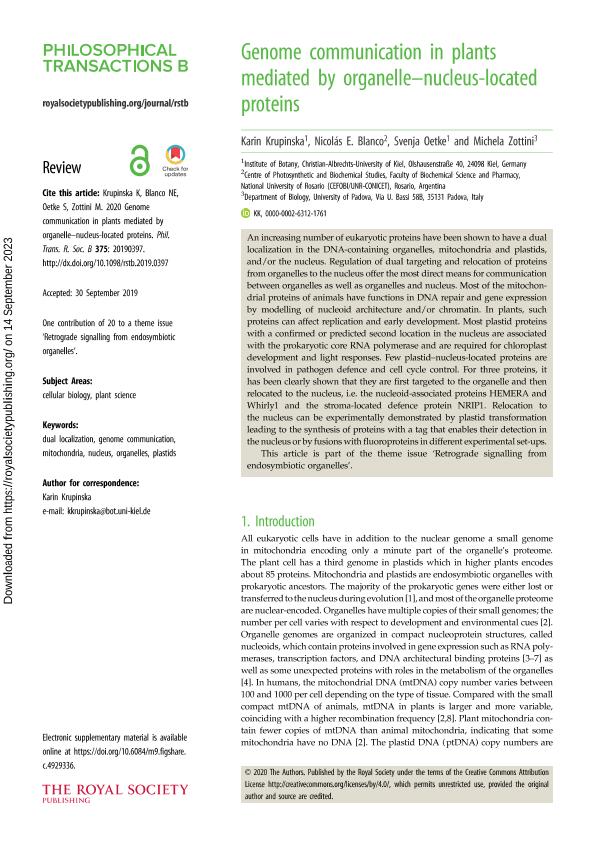Artículo
Genome communication in plants mediated by organelle–nucleus-located proteins
Fecha de publicación:
05/2020
Editorial:
The Royal Society
Revista:
Philosophical Transactions of the Royal Society B: Biological Sciences
ISSN:
0962-8436
Idioma:
Inglés
Tipo de recurso:
Artículo publicado
Clasificación temática:
Resumen
An increasing number of eukaryotic proteins have been shown to have a dual localization in the DNA-containing organelles, mitochondria and plastids, and/or the nucleus. Regulation of dual targeting and relocation of proteins from organelles to the nucleus offer the most direct means for communication between organelles as well as organelles and nucleus. Most of the mitochondrial proteins of animals have functions in DNA repair and gene expression by modelling of nucleoid architecture and/or chromatin. In plants, such proteins can affect replication and early development. Most plastid proteins with a confirmed or predicted second location in the nucleus are associated with the prokaryotic core RNA polymerase and are required for chloroplast development and light responses. Few plastid–nucleus-located proteins are involved in pathogen defence and cell cycle control. For three proteins, it has been clearly shown that they are first targeted to the organelle and then relocated to the nucleus, i.e. the nucleoid-associated proteins HEMERA and Whirly1 and the stroma-located defence protein NRIP1. Relocation to the nucleus can be experimentally demonstrated by plastid transformation leading to the synthesis of proteins with a tag that enables their detection in the nucleus or by fusions with fluoroproteins in different experimental set-ups. This article is part of the theme issue ‘Retrograde signalling from endosymbiotic organelles’.
Palabras clave:
DUAL-LOCALIZATION
,
MITOCHONDRIA
,
NUCLEUS
,
PLASTIDS
Archivos asociados
Licencia
Identificadores
Colecciones
Articulos(CEFOBI)
Articulos de CENTRO DE EST.FOTOSINTETICOS Y BIOQUIMICOS (I)
Articulos de CENTRO DE EST.FOTOSINTETICOS Y BIOQUIMICOS (I)
Citación
Krupinska, Karin; Blanco, Nicolás Ernesto; Oetke, Svenja; Zottini, Michela; Genome communication in plants mediated by organelle–nucleus-located proteins; The Royal Society; Philosophical Transactions of the Royal Society B: Biological Sciences; 375; 1801; 5-2020; 1-16
Compartir
Altmétricas




